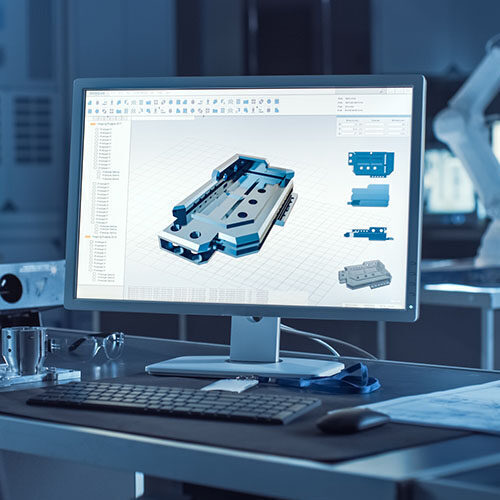
Your website serves as your calling card in the modern business world, meaning it must be accurate, informative, user-friendly, and easy to navigate. You also have a very short amount of time to make a good first impression with your website, as people typically decide within 5-15 seconds of clicking onto your site whether they want to continue browsing or not. In the latest installment of our Marketing for Manufacturers series, we will give you ten tips on how to revamp your website to make it an appealing and powerful marketing tool for your business.
An engaging website is one of the most effective marketing tools your small manufacturing business can have today. Before a potential client ever contacts you in person, they will have spent time researching and checking you out online, so you need an effective website that makes it easy for them to figure out who you are and what you do. As all of your other marketing channels — like email campaigns or PPC ads — will also point toward your website, it needs to act as a 24/7 salesperson and be the cornerstone of your marketing efforts.
10 Tips To Improve Your Website
Follow these ten tips to make your website stand out from the competition:
1. Get the Basics Right
It’s surprising how many companies don’t get the basics right. Ensure that your website clearly and accurately communicates who you are, what you do, and how to reach you.
Ensure that you clearly describe your business.
Visitors to your website need to know who you are and what you do at a glance. One way to do this is by using visual representations of your services in your main homepage banner (also known as the ‘hero image’) and subsequent page banners. But, also be sure to include an introductory text blurb near the top of your homepage that clearly states who you are and what your business offers.
Another way to make it easy for people to learn more about your business is to ensure that your About Us page links are readily available on both your main and footer navigation menus. This lets visitors easily find and delve deeper into the details of your business.
Put your contact information where it is easy to see.
If your business’s success depends on customers reaching you or your sales team, make sure that your contact information is prominently displayed — ideally above the fold on your homepage — so that visitors don’t have to search for a phone number or address. If you use social media to connect with your customers, include social links in your website’s header or footer, where they can be easily found.
Make sure your website is accurate.
Nothing turns somebody off more than finding inaccurate information on your website, whether it be a wrong number, out-of-date product information, or a basic grammatical mistake. Periodically check each page for accuracy, especially after making updates elsewhere, and proofread everything before it goes live.
2. Be Personal and Unique
Your website is all about selling your brand, so take the time to personalize it.
Make your website unique, just like you are. Think of ways to make you and your branding stand out from the crowd, and even invest a bit of money into this. Always follow good web design practices, but let some of your personality shine through. High-quality online experiences are essential to attracting customers to your business, so spending a little time and money on this is worthwhile.
Your About Us page should also not just be a dry block of text about your company: The people who work at your company are unique; use images of your team to personalize your business and stand out from your competition.
3. Create Customer-centric Content
To both rank higher on search engines and retain website visitors, regularly publish quality content on your website. Good content not only helps with SEO but also encourages people to visit your site over and over again.
Make sure your website is customer-oriented.
To engage with prospective customers and increase sales, consider what your customers want and need when planning website content. Think about what information would be helpful to them and what level of knowledge they may have. Use this knowledge as a jumping-off point to create content that gives potential clients something of value. Good content builds trust so that, over time, you can form a long-term relationship with readers that results in a sale.
Include testimonials.
Testimonials are a great way to show off your value to potential customers, and they can also help with SEO as they are also a great way to post fresh, high-quality content on your site.
4. Use Simple and Consistent Design Elements
The design of your website is just as important as the content on it. If you check out any professionally built websites, you’ll notice that they consistently use the same fonts, colors, logos, and styles across every page. That’s because keeping things consistent makes it easier for people to recognize your brand and understand your website.
Being consistent also saves time when building a website because you don’t have to worry about the look of every element — you already have a defined style in place. Before you create your whole site, determine the styles you will use, including creating a logo, your color palette, and fonts, plus how and where you plan to use them across your site.
If you want your site to be easy to read, try not to use too many different fonts (it’s best to keep to two or three across your website), colors, or GIFs — they can be distracting. Short paragraphs and bullet points also help make things easier to read, so try to stick to paragraphs that are no more than six lines long.
5. Learn How to Use White Space
Proper spacing is crucial when it comes to making a good website. It makes your text easier to read, your content more organized, and it helps people focus on the important parts of your page.
White space (or negative space) is vital to successful website design because it keeps your website from feeling cluttered. When you have white space around your text and titles, you can actually boost user attention by as much as 20%. Plus, having some white space on your site can make it feel modern and fresh, which can communicate that same feeling to the user about your own brand.
Make sure to keep your pages uncluttered.
Readers need to be able to put information in context: White space improves readability and helps you to group content together. When a website contains too much information and is too cluttered, it’s easy to become overwhelmed, and visitors won’t retain what they have learned about you. Be sure to use a good balance of text, images, graphics, and white space to create a clean, uncluttered page to focus your reader’s attention.
6. Organize Your Web Content
Few people will read every word on your website, and instead, they will scan it to find relevant information. Organize your website content using a visual hierarchy to make it easy for visitors to find the information they want.
A successful visual hierarchy emphasizes the most critical elements while making navigating your site easy for visitors. Professional website designers use a range of techniques, such as element size, color, contrast, and spacing, to guide a visitor’s attention across the page.
However, you can simplify this process by following three key rules: prioritize the most crucial elements by placing them at the top of the page and making them larger; use contrasting colors to highlight important elements like CTA buttons; and downplay non-essential details by placing them further down the page and making them smaller.
7. Create CTAs That Stand Out
Every page on your site needs to have a purpose and should contain a clear CTA, or call to action, that invites a reader to take a specific action such as calling your company, signing up for a service, buying a product, downloading a whitepaper, or doing something else that benefits your business goals.
Create CTAs — in the form of a button, link, or action words — that are noticeable and prominently placed on a page. It’s best to have at least one CTA that is above the fold so that readers do not need to scroll to get to it. Things you can do to make your CTAs stand out include using contrasting colors, incorporating multiple buttons throughout a page, combining a CTA with other elements to make the offer clear, and using different CTAs on each different web page.
8. Make Your Site Easy To Navigate
Visitors to your website might not always land on your home page first. You need to ensure that your site is easy to understand and navigate around no matter what page a visitor is on, or where they start.
Ensure you have an easy-to-use header bar.
A good header bar makes it easy for people to find the information they need from any page on your site. A good tip to follow is to keep your top menu simple, with only five tabs that are easy to understand. Then, make sure the pages related to each tab are neatly organized underneath it. Also, don’t forget to add a visible link back to the homepage, so people can always get there no matter where they are on your site.
Other elements you can use to make your site navigable are:
- Breadcrumbs show a visitor the path they have taken to get to a specific page. They typically appear at the top of the page and show the different pages visited, like a map. Breadcrumbs are helpful because they make it easy to return to the previous pages or other related pages on the website.
- A search bar that allows users to search for specific content or information on your site.
- Links in the body of the text make it easy for people to discover more information about the topics your article discusses.
- Expandable accordion blocks allow you to delve more deeply into a topic or answer a question without redirecting a visitor to a new webpage. This block lets you include more information without cluttering your page.
9. Use Responsive Design To Look Good on All Devices
Responsive web design means that your website looks good no matter what device someone uses to view it, whether a laptop, tablet, or phone.
Having a mobile-responsive website is crucial. Not only do most people spend five+ hours on their phones every day — making a positive mobile user experience a must — but a non-mobile-friendly site can also negatively impact your search engine ranking, making it harder for users to find your website when searching on Google. If your site is not easy to read or navigate on a mobile device, potential customers will choose your competitors instead.
10. Optimize Your Website for SEO
Search engine optimization (SEO) is a series of techniques you can use on your website to ensure that it is properly indexed and ranked by search engines, which increases its visibility to potential users. Once search engines crawl a website, it competes with similar websites, meaning that having high-quality design and content can improve your ranking and visibility on search engine result pages and put you ahead of your competition.
SEO can be the difference between either appearing on the first page of search engine results (which brings a lot of free traffic to your website) or on page 100 (which generates no traffic at all). Some things you can do to improve SEO are:
- Having a mobile-friendly site that is easy to navigate on mobile devices.
- Ensuring optimal website code that is free of errors and is easy for search engines to understand.
- Fast loading speed ensures users don’t lose patience waiting for your site to load.
- Being secure and having an SSL certificate installed to protect user data.
- Conducting keyword research and implementing keywords throughout your site to improve search engine ranking.
- Building high-quality backlinks from external websites with related content to drive traffic to your site.
- Encouraging positive reviews on Google, Yelp, Facebook, and other platforms to establish credibility.
- Using internal links throughout your site to guide users to related content and improve navigation.
- Using social media to link to your site and reach a wider audience on LinkedIn, Twitter, Facebook, Pinterest, and other platforms.
—-
Your website is the most important tool you have to market your business. Creating a great website takes time and effort, but your effort will pay off and help you effectively market your business and attract new customers. Using these tips to revamp your website will help you stand out from the competition and create a more engaging user experience for your visitors, which can boost traffic, raise conversion rates, and eventually boost the success of your company.
Stay tuned for the next installment in our Marketing for Manufacturing series, where we will talk about how you can stand out at tradeshows.
Get your eBook Scared to implement a new ERP?
"*" indicates required fields



